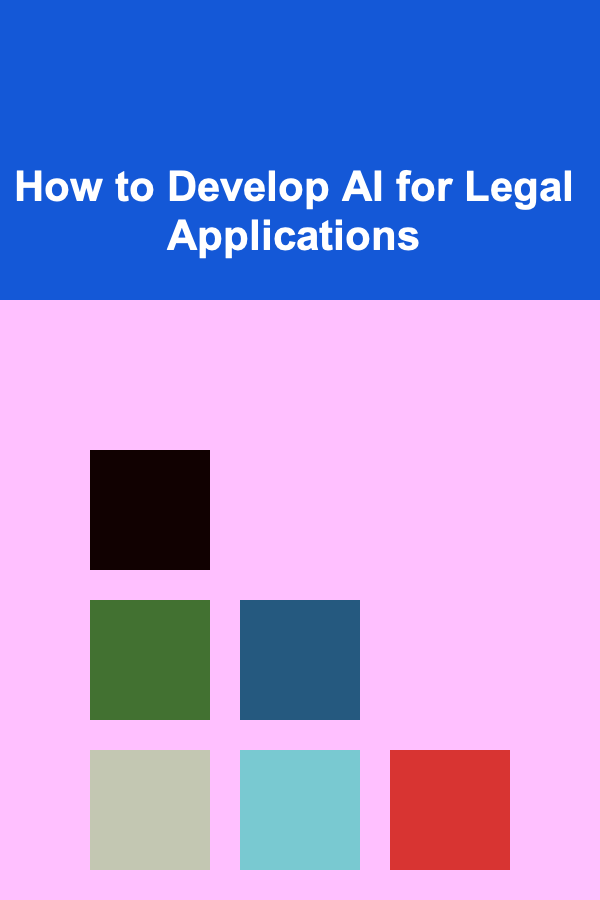
How to Develop AI for Legal Applications
ebook include PDF & Audio bundle (Micro Guide)
$12.99$8.99
Limited Time Offer! Order within the next:

Artificial intelligence (AI) has become an integral part of many industries, and the legal field is no exception. Legal applications of AI are growing rapidly, driven by the need for efficiency, accuracy, and the potential for cost savings in an industry that historically has relied heavily on human labor. However, developing AI for legal applications is no simple task. It requires a deep understanding of both AI technologies and the intricacies of the legal field. This article delves into how AI can be developed for legal applications, exploring the methodologies, challenges, and best practices for creating AI solutions in the legal domain.
Understanding the Legal Landscape
Before diving into the technical aspects of AI development for legal applications, it is crucial to have a solid understanding of the legal environment. The legal industry is unique because it is governed by complex, often ambiguous regulations and norms. Lawyers must interpret statutes, case law, and legal precedents to provide advice and make decisions. This is where AI can play a transformative role by automating certain tasks, analyzing large amounts of data, and supporting legal decision-making.
Legal AI applications span a wide range of functions, from document review and contract analysis to legal research and case prediction. Some common examples include:
- Document Review: AI can automate the review of large volumes of legal documents, identifying relevant clauses, summarizing key points, and even flagging potential legal risks.
- Contract Analytics: AI systems can analyze contracts to identify key terms, detect inconsistencies, and suggest improvements or potential issues.
- Predictive Analytics: By analyzing past case data, AI can provide insights into the likely outcomes of legal proceedings, helping lawyers make more informed decisions.
- Legal Research: AI can assist in the legal research process by sifting through vast databases of case law and legal articles to identify relevant precedents and statutes.
Key AI Technologies for Legal Applications
To develop AI for legal applications, it is essential to understand the technologies that power AI systems. The following are some of the most important AI technologies used in the legal domain:
2.1 Natural Language Processing (NLP)
Natural Language Processing (NLP) is at the core of most legal AI applications. The ability to understand, interpret, and generate human language is vital for any AI system working with legal documents, contracts, or case law. NLP enables machines to process large amounts of text and extract meaning, which is crucial in tasks such as legal research, document review, and contract analysis.
In the context of legal applications, NLP can be used to:
- Extract Key Information: NLP algorithms can identify key clauses, terms, or entities in legal texts, such as dates, parties involved, and case references.
- Summarize Documents: Legal documents are often long and complex. NLP techniques like summarization can provide concise overviews of lengthy texts, saving time for lawyers and paralegals.
- Sentiment Analysis: NLP can also be used to detect the sentiment or tone of legal documents, which can be important in understanding the intent behind a particular clause or statement.
2.2 Machine Learning (ML)
Machine Learning (ML) is a subset of AI that allows systems to learn from data and improve their performance over time without being explicitly programmed. ML is widely used in legal applications for tasks like predictive analytics, case outcome prediction, and risk assessment.
Some common ML techniques for legal applications include:
- Supervised Learning: In supervised learning, AI systems are trained on labeled data to make predictions. For example, a system could be trained on historical case outcomes to predict the likelihood of success in future cases.
- Unsupervised Learning: Unsupervised learning allows AI systems to find hidden patterns in data without prior labeling. This can be useful for clustering similar cases or discovering trends in legal documents.
- Reinforcement Learning: This technique involves AI systems learning through trial and error. While less commonly used in legal applications, reinforcement learning can be valuable for tasks such as decision-making in complex legal environments.
2.3 Knowledge Representation and Reasoning
In the legal domain, knowledge representation refers to the way information and legal rules are structured and stored in an AI system. Legal reasoning involves the process by which AI systems apply these rules to draw conclusions or make decisions.
Knowledge representation for legal applications often involves encoding legal principles, case law, statutes, and regulations in a structured format that an AI system can understand and reason about. Common approaches include:
- Rule-Based Systems: These systems use a set of predefined rules to infer conclusions from data. In legal applications, rules can be derived from statutes, case law, or regulatory frameworks.
- Ontologies: Legal ontologies represent a formal way of categorizing and organizing legal knowledge. They help AI systems understand relationships between different legal concepts and entities, such as laws, courts, and legal professionals.
- Logic-Based Reasoning: AI systems can use logical reasoning techniques, such as deductive or inductive reasoning, to apply legal rules to specific cases.
2.4 Deep Learning
Deep learning, a subset of machine learning, is particularly effective at handling complex tasks involving large datasets, such as image recognition, speech recognition, and natural language understanding. In the legal context, deep learning models, especially neural networks, can be applied to more sophisticated tasks like:
- Legal Document Classification: Deep learning models can classify legal documents into different categories, such as contracts, briefs, or motions.
- Case Law Analysis: Deep learning can help identify relationships between different legal cases and predict how courts might rule based on historical precedents.
- Text Generation: AI-powered text generation tools can assist in drafting legal documents, including contracts and agreements, by providing templates and suggestions based on existing legal language.
Developing an AI System for Legal Applications
The development of an AI system for legal applications involves several key steps, from data collection and preprocessing to model training and deployment. Below are the general stages involved in creating an AI system for the legal industry:
3.1 Identifying the Legal Problem
The first step in developing an AI solution is identifying a specific legal problem that AI can solve. Legal professionals often face repetitive tasks, such as contract review or legal research, that are time-consuming and prone to human error. AI can be used to automate these processes, but it is essential to define the scope and objectives of the AI system clearly.
- Problem Definition: What legal task or process does the AI system need to automate? For example, is the goal to analyze contracts, predict legal outcomes, or assist with legal research?
- Stakeholder Involvement: Lawyers, legal experts, and other stakeholders should be involved early in the process to ensure that the AI system addresses the specific needs of the legal field.
3.2 Data Collection and Preprocessing
AI systems rely heavily on data. For legal applications, this data often includes legal texts, such as case law, contracts, statutes, regulations, and other legal documents. The quality and quantity of data are critical factors in the success of the AI system.
- Data Sources: Legal datasets can be obtained from publicly available databases, law firms, government sources, or proprietary collections. Some common sources include Westlaw, LexisNexis, and PACER.
- Data Preprocessing: Legal documents often contain unstructured text that must be cleaned and formatted before it can be used for AI training. Preprocessing tasks may include tokenization, stemming, and removing irrelevant information such as boilerplate language.
3.3 Model Training
Once the data is prepared, the next step is to train machine learning or deep learning models on the data. This stage involves selecting the appropriate algorithms and adjusting hyperparameters to optimize performance.
- Supervised vs. Unsupervised Learning: Depending on the task, supervised learning (e.g., for classification tasks) or unsupervised learning (e.g., for clustering legal cases) may be more suitable.
- Model Evaluation: Evaluating model performance is crucial. Common evaluation metrics for legal AI applications include accuracy, precision, recall, and F1 score. Cross-validation techniques are also often used to avoid overfitting.
3.4 Integration and Deployment
Once the AI model has been trained, it must be integrated into the legal workflow. This may involve creating an interface that allows legal professionals to interact with the AI system, such as a web application or a desktop tool.
- User Interface (UI): Legal professionals should be able to interact with the AI system easily. The interface should be user-friendly and tailored to the needs of legal experts.
- Deployment: The AI system is then deployed to a production environment, where it can be used by legal professionals to automate tasks or assist with decision-making. Continuous monitoring and maintenance are required to ensure the system performs optimally.
3.5 Ethical Considerations and Compliance
Developing AI for legal applications requires careful attention to ethical and legal considerations. AI systems must adhere to privacy laws, data protection regulations, and ethical guidelines, particularly in fields such as criminal justice, where the consequences of AI decisions can be significant.
- Bias and Fairness: AI systems must be regularly audited to ensure they are free from bias. In the legal context, biased AI models can lead to unfair or discriminatory outcomes.
- Transparency: AI models used in legal applications should be interpretable and transparent, particularly when their decisions impact people's rights and liberties.
Challenges in Developing AI for Legal Applications
While AI has enormous potential in the legal field, there are significant challenges that developers must address when creating AI systems for legal applications. These include:
4.1 Data Quality and Availability
Legal data is often unstructured, complex, and fragmented. Gathering sufficient, high-quality data can be a significant barrier to the development of AI systems for legal applications. Moreover, legal data is often subject to privacy regulations, making it difficult to access certain datasets.
4.2 Legal Complexity and Variability
The legal domain is highly complex, with varying laws and regulations across jurisdictions. AI systems must be adaptable to these differences and capable of understanding the nuances of different legal systems.
4.3 Trust and Adoption
Lawyers and legal professionals may be hesitant to trust AI systems, especially when it comes to complex legal reasoning and decision-making. Gaining the trust of users and ensuring that AI systems are reliable and accurate is crucial for widespread adoption.
Conclusion
Developing AI for legal applications holds immense promise for transforming the legal industry by improving efficiency, accuracy, and cost-effectiveness. However, building effective AI systems for legal purposes requires careful attention to the legal domain, advanced AI technologies, and ethical considerations. By leveraging natural language processing, machine learning, and other AI techniques, developers can create tools that automate tedious tasks, enhance legal research, and even predict case outcomes. As the legal industry continues to embrace AI, the future holds exciting possibilities for how these technologies can support legal professionals and revolutionize the way legal work is done.

How to A/B Test Geotargeted Ads for Your Dropshipping Store
Read More
How to Develop an Online Health and Nutrition Coaching Program
Read More
How to Sublet Your Rental Property Legally and Safely
Read More
The Operations Supervisor's Playbook: Best Practices for Streamlined Operations
Read More
How To Record Interviews with Multiple Cameras
Read More
10 Tips for Reducing Electromagnetic Interference (EMI) in Electronics
Read MoreOther Products

How to A/B Test Geotargeted Ads for Your Dropshipping Store
Read More
How to Develop an Online Health and Nutrition Coaching Program
Read More
How to Sublet Your Rental Property Legally and Safely
Read More
The Operations Supervisor's Playbook: Best Practices for Streamlined Operations
Read More
How To Record Interviews with Multiple Cameras
Read More